

Businesses run on processes. From hiring procedures to risk assessments and goal setting, processes and workflows run in the background to ensure you meet your objectives.
Verifying you have effective processes in place can make the difference when it comes to being successful. That means you can’t just let processes do their thing, you have to play an active role in crafting, developing, and constantly improving these workflows.
One way to do that is to conduct workflow analysis. This involves regularly reviewing your workflows and procedures to see what works well and where to make improvements.
Here, we’ll dive deeper into workflow analysis and list the benefits of this type of review. Plus, we’ll show you the different types of workflow analysis, offer a step-by-step approach to conducting workflow analysis, and provide real-life examples to guide your efforts. ✨
What is Workflow Analysis?
Workflow analysis is the process of reviewing procedures with the goal of making them more efficient. This type of analysis is integral to business management.
It involves examining which workflows are inefficient and then using those insights to create better solutions. For example, you might identify repetitive manual tasks that can be automated or find a new way to divide work based on your team’s bandwidth.
In short, workflow analysis is a way for you to examine trends in your workflows, discover weaknesses in your process, and generate takeaways for improvement. 📝
In general, the workflow analysis process includes:
- Documenting the existing workflow
- Identifying weak areas or roadblocks
- Determining tasks that are ideal for automation
- Creating action plans incorporating analysis insights
4 Benefits of Implementing a Workflow Analysis
There are many benefits of workflow analysis, including better efficiency, clearer expectations, and simpler compliance with regulations. Not only does workflow analysis streamline the internal workings of your business processes, it also creates a better work environment and positions you to be more competitive on the big stage.
Here are some of the main benefits of workflow analysis.
1. Better efficiency across different teams
The key goal of this analysis is to reengineer business processes and make them more efficient. By streamlining your workflows, you can focus on the big goals at hand, without things falling through the cracks.
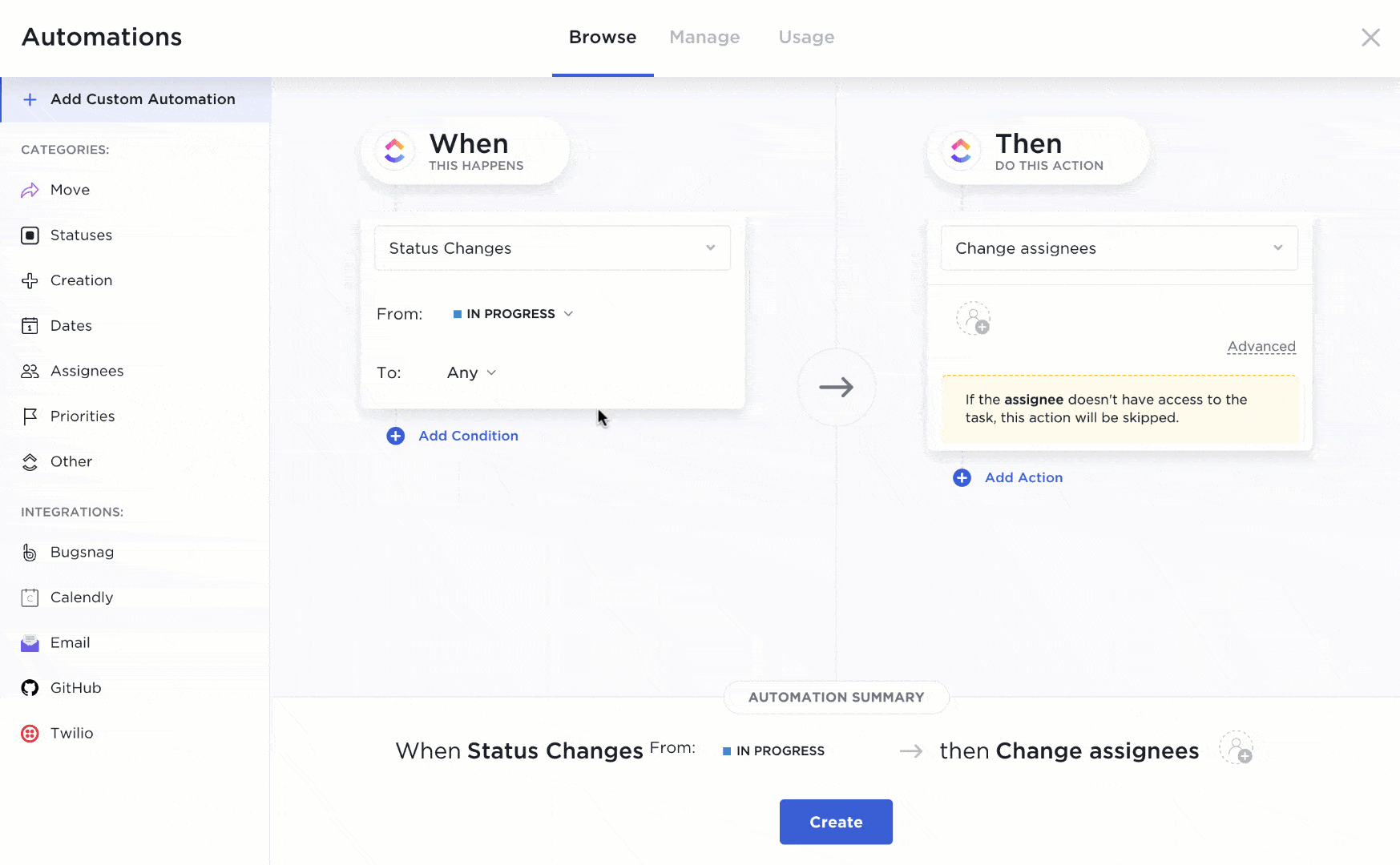
Reviewing processes also means cutting out redundant tasks, assigning grouped tasks to the correct team members, and prioritizing tasks that have dependencies. Using a workflow management tool turns up workflow automation opportunities where you can free up a team member’s time so they can focus their efforts elsewhere. 👩💻
2. Increased adaptability to spot and avoid bottlenecks
Proper workflow analysis is an ongoing process. That means you don’t do this process just once.
Instead, you should schedule a workflow analysis quarterly or yearly to reevaluate how you are doing things. Incorporate this as a final step in a project so that you can start laying the groundwork for successful future projects based on existing project feedback.
By constantly reviewing your procedures, you’re better able to adapt to market changes, customer satisfaction and preferences, and employee turnover. You’re also better prepared to handle bottlenecks by documenting strengths and weaknesses you’ve had in the past and insights into how you solved them.
3. Happier employees mean more efficient workflows
Workflow management and analysis build a better working environment—especially when it comes to employee engagement.
Employees don’t have to deal with old, outdated technology. Encourage your team to make suggestions when it comes to process improvement tools. Since they’re the ones working with workflow management software every day, they are well-positioned to give insight into what needs improvement.

Not only does this lead to better workflows, but it also empowers your employees. They feel heard and respected and have greater autonomy and control over their work processes. 🤩
4. Easier compliance and regulatory frameworks
For business processes at healthcare companies, government agencies, and finance or banking firms, workflow analysis tools make regulatory compliance more straightforward. It gives you insight and structure so everyone knows what’s required and provides updates on real-time progress.
Analyzing your existing business process lets you develop the structure for better compliance. Create knowledge databases as part of your workflows to list all required regulatory frameworks, assign tags to tasks to track accountability, and create steps for quick audit reports.

The Main Types of Workflow Analysis
There are three different types of workflow analysis. Each one shares the goal of improving workflow processes and boosting efficiency. 💪
Here are the three workflow analysis types:
- Linear workflow analysis: This type of review focuses on processes that work in a straight line. This method is best for organizations that have clear task steps, well-defined processes, and clear employee responsibility
- Cross-functional workflow analysis: This analysis type is designed for reviewing processes across departments or at organizations where there isn’t a clear delineation of tasks steps
- Hybrid workflow analysis: This type is focused on scrutinizing workflows across departments and within departments. It’s ideal for evaluating processes on projects where different departments are involved, but there are also processes within departments that need to be streamlined
Each type of workflow analysis can be used to improve business workflows. Think about your company or project structure, and choose the best type of analysis to meet your workflow optimization needs.
How to Conduct a Workflow Analysis
Ready to incorporate analysis into your workflow management system? Here are four workflow analysis steps to better conduct and map out an effective business process. 🗺️
1. Collect data to understand what needs to be improved
Before you can start optimizing, you need to gather insights into what’s working and what needs to be improved. The type of data you need will vary depending on what type of workflow you are optimizing.
Be sure to assess both quantitative data (like the number of incomplete tasks) as well as qualitative data (e.g., how team members feel about resources required for the task).

The best way to gather data is to go through your existing process using a tool like ClickUp Whiteboards to create process flowcharts, which lets you track and optimize your operations using visual diagrams. Go step by step and take notes on who’s responsible for which deliverables and highlight potential roadblocks. ⚠️
You also want to conduct interviews with employees to get insight into the ground level of the project. For more complex projects, host a workshop where each employee can walk you through their workflows.
Some data you want to look for include:
- The number of tasks each team member is responsible for
- The general time frame of the project tasks
- The amount of time it takes to complete a task
- The number of times a task is repeated
- How often tasks are completed or rejected

Use ClickUp Dashboards to display and analyze data. It provides a high-level overview of all tasks that are part of meeting the company goals. Quickly view what’s in progress and what’s behind schedule. Plus, identify redundancies so you can adapt your workflows for better efficiency with an overview of your cross-functional workflow analysis.
2. Analyze the data to uncover areas of improvement
Once you’ve gathered insights, it’s time to analyze the data. Remember, the main goal is to optimize processes that aren’t working. Sometimes you’ll make big changes, other times minor adjustments may be needed.
ClickUp makes it easy to analyze custom data thanks to its workflow management features. You can create a Workflow Diagram to get a visual roadmap of all your existing processes. This way, you can uncover bottlenecks and document existing systems that need improvement.
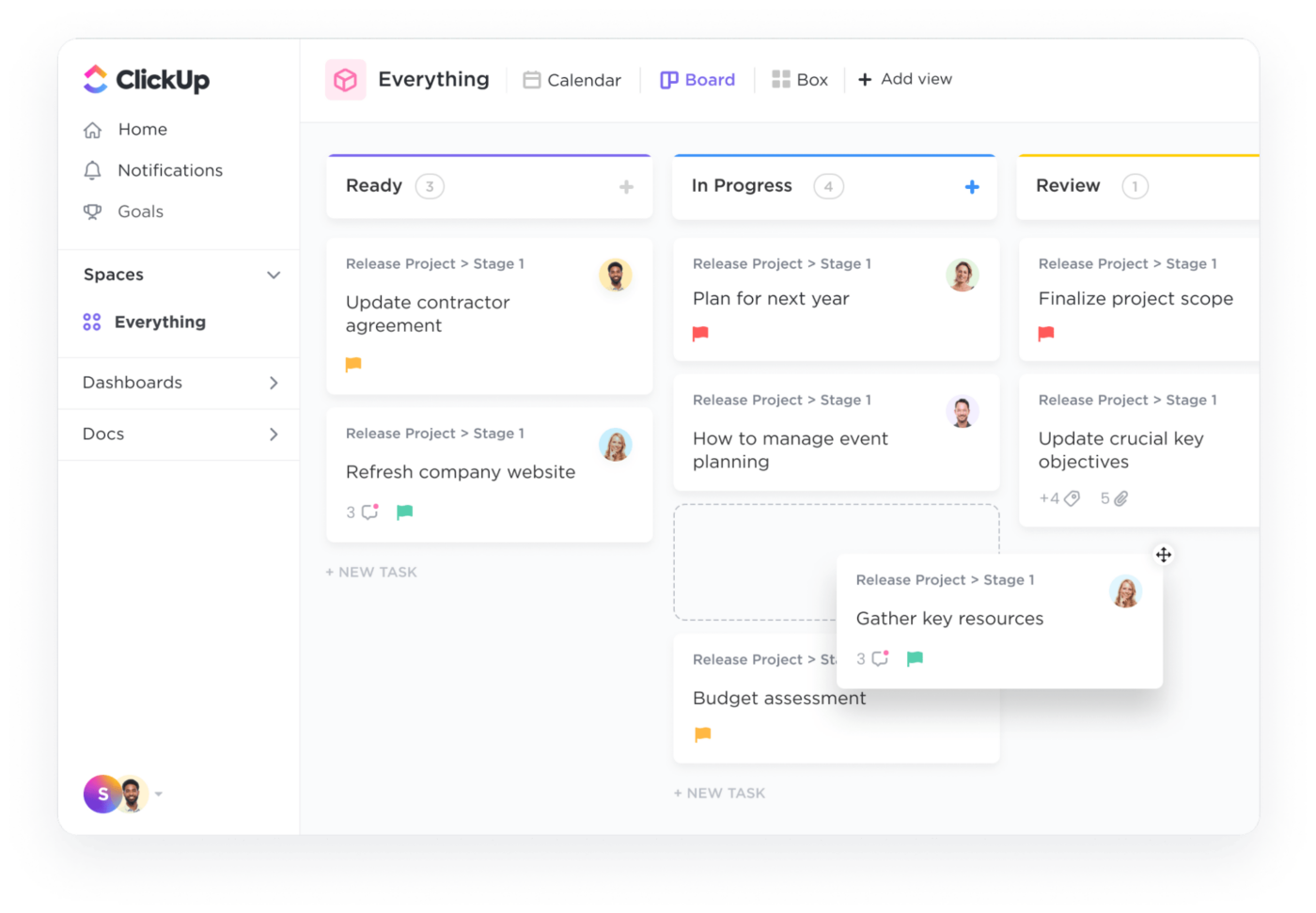
Another great tool is the ClickUp Board View where you can scroll through every task and swiftly see how it moves through project stages.
Look at the data you’ve collected and ask yourself the following questions:
- Is this task or process necessary?
- What’s the goal of this task?
- Is it serving a valuable purpose?
- Is this task time-consuming?
- Are there metrics to gauge performance?
- Does this process offer a friendly user experience?
- Does this require a steep learning curve or significant onboarding resources?
- Do employees have the resources they need to complete the step?
- Can this manual process be automated?
It’s also useful to examine which changes will have the highest impact, especially if you’re short on time or have limited resources.

ClickUp Task Priorities let you choose from four flags to identify the most important items. Prioritize changes that have the highest impact and least work required first. These can make a big difference without impacting your budget, and you can work on addressing less-pressing changes next. 🙋🏻♂️
3. Implement changes from your findings
Once you’ve reviewed your data, you should have insights into what changes need to be made to your workflows.
Maybe you’ve identified tasks that will take less time if they are automated. Perhaps you’ve determined areas where handoffs to other team members can be streamlined. Maybe you’ve decided you need new workflows or want to establish project controls when necessary to stay within your budget.
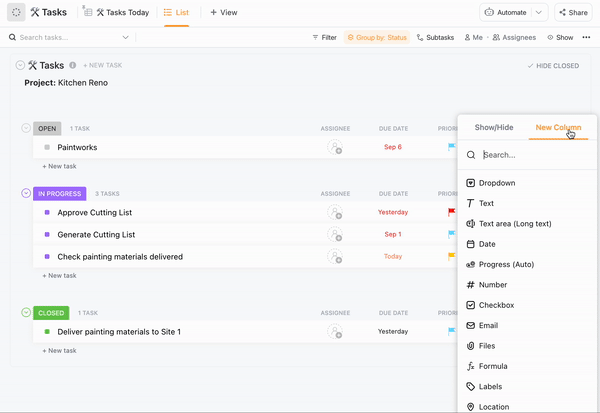
Whatever the data tells you, think about how you can make changes to streamline the workflow.
Process automation tools like ClickUp’s Whiteboard feature, let you visualize changes to the workflow. Once you have the workflow finalized, you can create tasks in seconds directly from the Whiteboard and add context with documents, descriptions, and files. 💪
Be sure to let all stakeholders know about the changes. From the project management team to the human resources department, notify anyone that is involved in the process. Create clear guidelines and instructions for changes so everyone knows what is expected moving forward.
4. Regularly review your business workflow
Workflow analysis doesn’t end with implementation. You should review and analyze your processes regularly to ensure workflow efficiency and keep things running smoothly.
Set a schedule to review workflow performance. Leverage reporting tools and retrospective tools to consistently monitor how things are progressing.
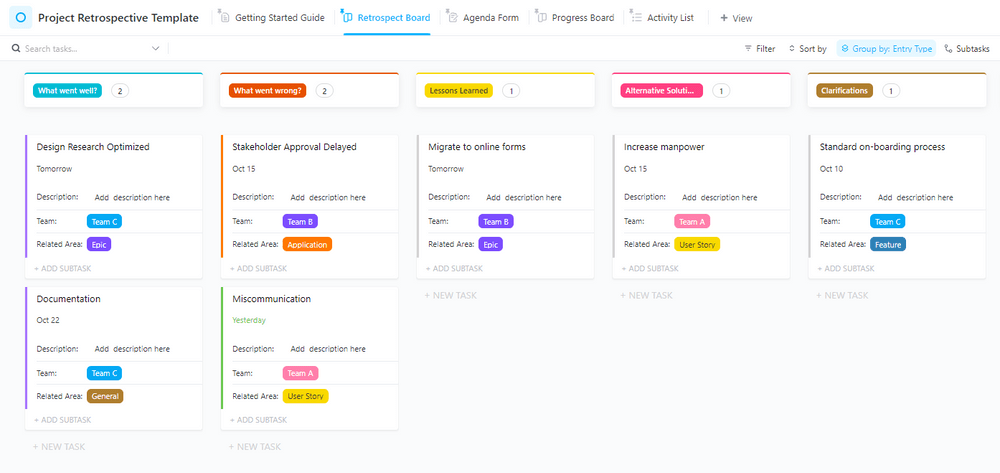
In fact, you can use the ClickUp Project Retrospective Template to easily collect feedback, find strengths and weaknesses in the workflow, and make changes for improvements in future projects. ✍️
Have conversations with your team members to ensure everyone is on the same page. You’ll get valuable feedback that you can implement and can improve your workflows based on employee suggestions.
3 Workflow Analysis Examples
All of this sounds great in theory, but in practice, it’s even better! Want some real-life workflow analysis examples? We’ve got you covered with these different use cases. 👀
Use case 1: Simplify company growth
As companies become more successful, they tend to grow. Processes and procedures you used with a small team of five to 10 people suddenly start to break when you scale up to 50 employees or more. That prevents roadblocks to efficiency and can even hinder your growth.
You need a more fine-tuned or segmented workflow system to keep up with the changes. Use workflow automations to create a new roadmap for success with a larger team and improve these processes.
Plus, as you have more people on board, you’ll get more diverse insights and a greater range of feedback, resulting in creative solutions. 🥳
Use case 2: Streamline manual processes
Many project managers and their teams handle repetitive tasks manually. Sometimes that means responding to client invoices via email. Other times, that work may include writing the same blog article brief over and over again from scratch.
These tasks take time and when you start scaling up or working on bigger projects, they can turn into a time suck.
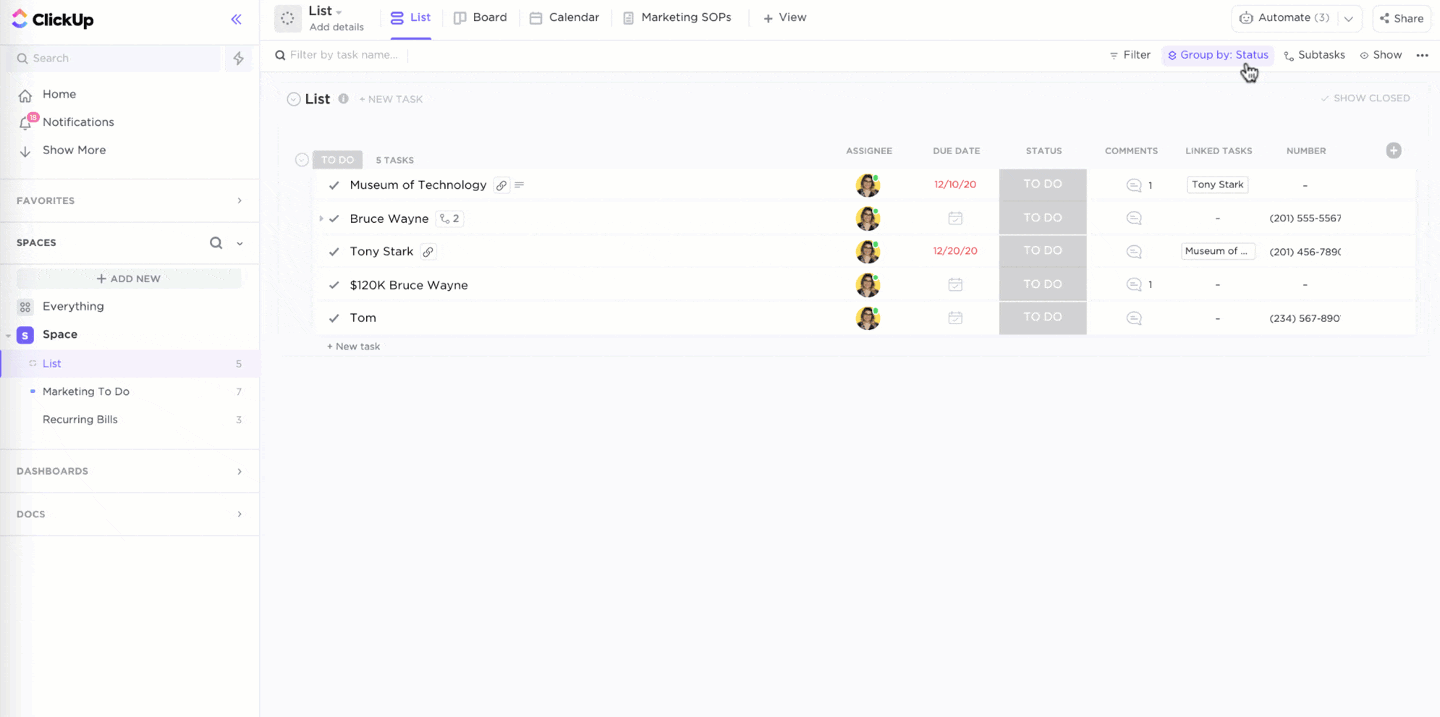
Automate manual processes whenever you can. That might mean using finance tools like QuickBooks to handle payments and invoices. It can also mean using content creation apps and other templates to reduce the time it takes to create repetitive content. ⌚️
Use case 3: Engage with customers more effectively
Communicating with customers is huge. You want feedback from users so you can provide better products and services.
For small businesses, it’s easy to connect with customers on a personal level. You respond to their emails, offer advice on how to use your products and services, and troubleshoot issues as they arise.
With a larger company and several full-time employees—or as you take on bigger projects—it can be harder to handle those tasks yourself. Plus, your efforts are likely better focused on larger goals and more important tasks.

A CRM workflow tool is a better way to manage customer relationships with automated workflows. After analyzing your existing processes, you can use the CRM to automate responses and generate tasks for relevant team members. 📚
Conduct Workflow Analysis and Streamline Your Processes With ClickUp
Support business operations and lead more efficient teams by adding workflow analysis to your to-do list. With this handy guide, you have everything you need to collect data, analyze the results, and create action items from your workflow review.
Try ClickUp today to take advantage of workflow features including diagrams, flow charts, and hundreds of templates that are designed to make your work more methodical. Each one is customizable so you can leverage the tool to meet your specific business needs. 🏙




